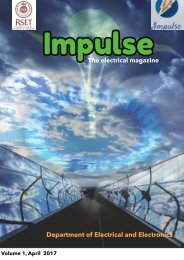combinepdf
You also want an ePaper? Increase the reach of your titles
YUMPU automatically turns print PDFs into web optimized ePapers that Google loves.
Unmodeled Dynamics:<br />
Mathematically, it is impossible to model a practical system perfectly. There always exists some<br />
unmodeled dynamics. The situation may be worsened if the unmodeled dynamics contains high-frequency<br />
oscillatory dynamics which may be excited by the high-frequency control switching of SMC. There are<br />
several aspects of dealing with this unmodeled dynamics.<br />
More broadly, in the complex systems environment, the object to be controlled is difficult to model without a<br />
significant increase in the dimensions of the problem space. Often, it is more feasible to study the component<br />
subsystems linked through aggregation. The challenge is how to design an effective SMC without knowing<br />
the dynamics of the entire system (apart from the aggregative links and local models). This research topic has<br />
been very popular in recent years in the intelligent control community using, for example, NNs, FL, and<br />
PR,where PR technology is being focused here.<br />
SC TECHNOLOGIES<br />
In this section, some brief introduction to the key SC techniques which are commonly used in dynamical<br />
systems and control. Components of SC technologies are NNs, FL, and PR which subsume belief networks,<br />
evolutionary computation (EC), chaos theory, and parts of learning theory.<br />
PR refers to EC, chaos theory, belief networks, and parts of learning theory. Below are some brief overviews<br />
of the area.<br />
Among PR technologies, EC techniques have been a most widely used technology for optimization in SMC.<br />
The EC paradigm attempts to mimic the evolution processes observed in nature and utilize them for solving a<br />
wide range of optimization problems. EC technologies include genetic algorithms (GAs), genetic<br />
programming, evolutionary algorithms, and strategies. In general, EC performs directed random searches<br />
using mutation and/or crossover operations through evolving populations of solutions with the aim of finding<br />
the best solutions (the fittest survives). The criterion which is expressed in terms of an objective function, is<br />
usually referred to as a fitness function.<br />
INTEGRATION OF SC METHODOLOGIES<br />
The aforementioned SC paradigms offer different advantages. The integration of these paradigms would give<br />
rise to powerful tools for solving difficult practical problems. It should be noted that NNs and EC are about a<br />
process that enables learning and optimization while the FL systems are a representation tool. Emerging<br />
technologies such as swarm optimization, chaos theory, and complex network theory also provide alternative<br />
tools for optimization and for explaining emerging behaviors which are predicted to be widely used in the<br />
future.<br />
SMC WITH SC<br />
There has been extensive research done in using SC technologies for SMC systems. An earlier survey<br />
already out-lined some of the major developments. Since then, significant research has been progressed and<br />
this paper aims to depict the state of the art of SMC with SC. We will use the same categories as in Section<br />
III to summarise the developments.<br />
As has been stated before, the integration of SMC and SC has two dimensions. One is the application of SC<br />
technologies in SMC to make it “smarter” and the other using SMC to enhance SC capabilities. This survey<br />
will be confined within the scope of the former, i.e., the application of SC technologies in SMC.<br />
SMC WITH PR<br />
One PR technology commonly used in SMC is the EC for optimisation. Another area is the application of<br />
chaos theory in SMC. We shall discuss their applications in SMC in the following.




